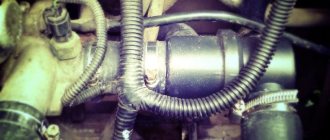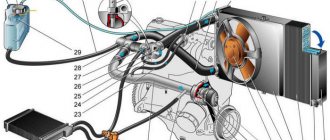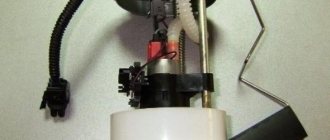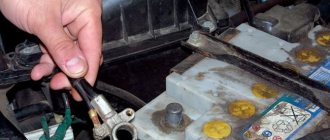Which thermostat is better for VAZ 2114
FAQ How to choose a thermostat, and which thermostat to buy.
How to choose a thermostat, and which thermostat to buy.
Buying a thermostat
- this is a question even more pressing than its verification. And you can get burned when choosing a thermostat as easily as you would get burned on a hot kettle.
The parts seller says:
There is no point in lying to our clients, showing what kind of specialists we are and how we understand our business. Therefore, keep it clean.
When choosing a thermostat, 70 percent of drivers say: “give me the cheapest one.” Only the remaining 30 percent tries to touch the rubber seals, press on the valve and pull the rod until it sticks. The difference between the two halves is big. If the other half is still somehow trying to choose a quality item, but out of ignorance is trying to push through a rod curled into a spring, which reacts only to changes in temperature, and then asks why it doesn’t work, then there is no point in explaining anything to the other half and all that remains is to send a person to the fair, where he is more welcome than ever.
Therefore, the remaining 30% half may benefit from the following information.
What to pay attention to when purchasing:
The first, and perhaps the last, is the metal of the thermostat housing. The main problem is corrosion. Buy a Chinese thermostat once and see how within a year it is covered with rust, and the shine that looked like stainless steel turns out to be not stainless steel at all. Choose a thermostat with a stainless steel or brass body. These thermostats will not corrode for many years.
There are no other selection criteria anymore. Not a single hologram or sticker on the packaging of the most expensive thermostat says anything other than that it exists. Do not press the valve. It will only work at the set temperature. This is not a spring. This is a rod made of a special material that is curled in a spiral.
You won’t be able to check the thermostat for functionality at the store counter. Therefore, check it before installing it in hot water, at least for smooth opening and closing. Thus, make sure that the thermostat rod does not jam and that everything is in order with it.
It happens that the engine overheats or, conversely, in winter it is impossible to warm up the car interior to normal temperature. All these are consequences of a malfunction of the thermostat, which is responsible for the circulation of antifreeze in the engine cooling system.
The thermostat ensures quick warm-up of the car at low temperatures and also prevents the engine from overheating. A thermostat malfunction can be detected by looking at the instrument panel. The coolant temperature sensor arrow will be in the red, unacceptable zone. In winter, you may notice that the car interior does not warm up well.
In the first case, the thermostat is always closed and the coolant circulates in a small circle. In this case, only a small part of the heat from the engine is “thrown out” into the environment. Therefore, the engine may overheat. In the second case, the thermostat is constantly open and the engine does not have enough of its own heat to warm up to operating temperature. Increased fuel consumption is possible here.
If you suspect that the thermostat is faulty, then you should remove it. First, drain the coolant and then remove the thermostat. In different models, the thermostat is removed in different ways, so we will not dwell on this.
So, the thermostat has been removed. Now you need to remove all scale and dirt from it and clean the small hole in the valve. The thermostat is checked as follows. We put some container with water (for example, a saucepan) on the electric stove and heat it (we also need a thermometer with a scale of more than 100 degrees). The thermostat must be checked according to two criteria: valve opening moment and dimensions. The first criterion is the temperature at which the thermostat valve opens. Most often, the temperature is indicated on the thermostat housing and ranges from approximately 81-85 degrees (VAZ) to 92-93 (some foreign cars, as well as thermostats of modern domestic engines).
Sometimes you can check the thermostat by size: before heating and after. Use a caliper - measure the distances between two points before and after heating. Most often, the difference in distances should not be less than 7 mm.
When the thermostat has cooled down, you need to check whether the valve is completely closed. If a malfunction is detected, the thermostat can only be replaced; it cannot be repaired.
Installation
In addition to the thermostat, you need to purchase a new pipe through which the coolant can return to the pump. Among motorists it is called a “saxophone”. You can find it by number: 2110-1303055-10. The following tools and materials should also be on hand:
- Clamps 15-28 mm (it is better to take about 7 pieces).
- New gasket.
- Replacement hoses.
- Screwdriver Set.
- Special hose puller (needed for old-style cars).
- Rags.
- Antifreeze.
There are two installation options: standard and alternative. In the first case, the 6-hole thermostat opens for additional cooling. In other words, it monitors the temperature coming out of the engine, not the temperature of the already cooled antifreeze. An alternative option is to check the temperature lower than the motor reading. The installation proceeds according to the following scheme:
- Part of the coolant must be drained; to do this, you need to unscrew the plug from the drain hole;
Along with the drop in temperature due to the gradual arrival of winter, it began to get colder in the car. It began to take more time to warm up the engine, then wait for the coolant temperature to rise to 60 degrees to turn on the heater and warm up. In this regard, I remembered the modification of the cooling system of the VAZ 2109, when instead of the standard thermostat, a 6-hole thermostat from the VAZ 2110 is installed. It is improved in comparison with the standard one and has the following advantages:
— the thermostat has been modified to ensure a more stable coolant temperature; — fewer connections on clamps. The standard thermostat is attached to the outlet pipe through a rubber connecting tube; — the thermostat is made collapsible for the possibility of replacing the thermoelement separately from the body; — the new thermostat is 5 cm shorter than the standard one — there is more space.
To remove the thermostat and not spill antifreeze, you must first release the pipe on the throttle assembly and drain what spills out through it. All you have to do is be careful and not spill antifreeze when disconnecting the return pipe from the heater radiator.
We connect a new thermostat with 6 holes according to the following diagram:
Connecting a 6-hole thermostat according to the standard diagram
It will be necessary to install a new pipe through which the antifreeze is sent back to the pump, the so-called “saxophone” (2110-1303055-10), it is shorter than the standard one from the VAZ-2109. However, newer cars already have this pipe installed from the factory. You may also need hoses, clamps, and a gasket for a new thermostat. It is advisable to try on the thermostat and determine locally whether the hoses will need to be replaced.
Above is a standard connection diagram for a 6-hole thermostat. However, it is recommended to connect such a thermostat using a different, modernized circuit.
Modified thermostat connection diagram for VAZ 2109, VAZ 2108 “injector”
Modified thermostat connection diagram for VAZ 2109, VAZ 2108 “carburetor”
Connecting a 6-hole thermostat
The meaning of this connection is that the coolant, which has given off heat in the heater radiator, is directed back to the temperature-sensitive element of the thermostat (rather than drained into the receiving pipe to the pump), and cools it a little, preventing the large circle from opening until the temperature of the antifreeze coming from the heater won't rise. It turns out that now the thermostat also takes into account the temperature of the coolant from the heater radiator, which makes the engine temperature more stable, and the car will be warmer in winter. To connect you will need a special tee.
With such a system for connecting a 6-hole thermostat, there is no need to install cardboard boxes so familiar to all owners of domestic cars in front of the radiator. In summer, there are no differences in the operation of all types of thermostats.
For comparison and understanding of the nuances of operation, below are the standard cooling systems of the VAZ 2109, VAZ-2108.
If the thermostat fails, the engine will take a very long time to heat up to the required operating temperature, and while driving, the engine temperature will drop sharply. This is especially felt in winter due to a poorly heating stove.
Appearance of the device
We choose which thermostat is better to install on the injection 8 valve VAZ-2114
The engine temperature affects not only the temperature of the heater, and this, unfortunately, is what worries the owners of Togliatti cars primarily. This does not speak of their shortsightedness, but of the imperfection of the heater, but today we are not talking about it. The temperature regime of the engine depends on one simple but very important device called a thermostat . When we learn more about the modifications of VAZ devices, the question of which thermostat is better to install on the injection VAZ-2114 will automatically disappear.
Testing
The last step is to check the operation of the heater. A uniform flow of warm air indicates that the replacement was done correctly . Do it right and it won't take long. Good luck!
The performance and condition of the engine depends on the health of the cooling system. Its important element is the thermal regulator, which on domestic cars often fails for various reasons. To test or replace it, the owner needs to know where the thermostat is located on a VAZ 2114. This article will tell the car enthusiast how this part works, where the thermostat is located on a VAZ 2114, how to check it and select the right spare part.
Why do you need a thermostat?
We will not organize courses on eliminating automotive illiteracy, because every self-respecting driver knows that the thermostat directs the coolant either in a large circle (including the engine cooling radiator) or in a small circle (bypassing the radiator).
Thermostat for VAZ-2114 injector
The operating algorithm of the device depends on the thermodynamic valve, which closes one pipe in the thermostat and opens the other. Before changing the thermostat, it must be checked.
To refresh your memory of its structure, we have provided a diagram of the VAZ-2114 thermostat and attached it below.
Scheme of operation of the cooling system (thermostat)
As can be seen from the diagram, this is a simple device with a thermal valve, which, when a certain temperature is reached, is activated, thus directing the antifreeze in a small or large circle.
In most cases, it has three pipes - one inlet and two outlet . through which the coolant flows either directly from the pump into the heater and further through the cooling system, or into the radiator if its temperature has reached the required value. It is the temperature value at which the device operates that determines the use of the thermostat on a particular VAZ model, although there are still some nuances that specifically concern the VAZ-2114 injector.
Video about the operating principle
HOW THIS DEVICE IS SET UP
All parts of the thermostat are placed in its housing, which can be made of metal or high-strength plastic.
Inside the case there are:
- Bypass valve;
- Main valve with spring;
- A solid filler that acts as a heat-sensitive element;
- Outlet pipe;
- Piston with holder,
- Inlet pipe from the motor;
- Spring from bypass valve.
Probably all drivers know where this part of the cooling system is located, but for those who forgot or did not know, let us remind you. This device is located between the radiator of the cooling system and the engine. It is worth running your hand along the rubber pipe coming from the bottom of the radiator, and it will lead to this important element. Find it under the air filter housing.
Types of VAZ thermostats and which one is better
Visually, even an experienced salesman cannot distinguish a kopek thermostat from a Niv one. Because the difference is inside them and in the location of the pipes. All Togliatti thermostats are made according to the ancient Fiat design - they are removed from the cylinder head into a separate unit and fixed to the pipes and hoses of the cooling system. Here are the main types of VAZ thermostats:
- All classic Zhigulis had a 2101 thermostat under the hood . which can be identified by the location of the pipes, they are turned opposite each other almost at a right angle. However, the most important difference is that the thermal operating conditions of rear-wheel drive Zhiguli engines required blocking the valve at 80 degrees and fully opening it at an antifreeze temperature of 95 degrees.
Exactly the same device was installed and is being installed on Niva . The only difference is that the angle between the pipes tends to 180 degrees.
Thermostat VAZ 21213, 21214 (Niva)
The eight thermostat is installed on all carburetor Samaras in their countless modifications. The difference with classic motors in terms of thermoregulation is that in thermostat 2108 the valve should operate seven degrees later. This happened due to the more advanced design of the combustion chamber, so until the antifreeze temperature reaches 87 degrees, the valve should be closed, and only at 102 degrees should it open.
Modern thermostats on the spare parts market are not distinguished by high accuracy and high quality workmanship, so after a series of tests the plant gave two degrees to the manufacturers. As a result, on boxes with thermostats for the entire Samara family, you can often see the number 85. Visually, the 2108 thermostat is distinguished by the presence of a thin pipe to remove possible air bubbles. The tenth VAZ family received exactly the same thermostat housing as on the classic, but in a mirror image. It does not have a small pipe for air outlet, since the design for the carburetor tens provided a separate tee, which greatly complicated the decoupling of the hoses under the hood. By the way, the figure-eight device is also perfect for carburetor tens; the only thing you need to do is tightly plug the small air hole.
Such thermostats have become the most popular, so when purchasing them, you should definitely look inside; there should be a curtain made of plastic or metal, which better redistributes the flow of liquid to the thermoelement. If it is not there, the valve response temperature can differ greatly (up to 10-15 degrees) from the nominal value, which leads to engine overheating. The thermostat of the 2112 family is designed specifically for injection VAZ engines . Actually, the thermostat doesn’t care what type of power system it is, it does its job and if the manufacturer is conscientious, the valve will always be closed up to a temperature of 85 degrees.
What is better than a thermostat with “ten”?
Of course, we are not talking about the models that were included in the first “ten” releases. The VAZ-2109 thermostat (carburetor) is very similar to the one that was installed in the first “ten” models. But now we are talking about more modern models. Their main advantage is that the number of clamps is reduced to a minimum. But the thermostat is not attached to the engine block using a short pipe. The housing is screwed to the engine block using two studs. The temperature sensor is screwed into the thermostat, therefore, the second hole must be plugged.
In addition, when installing the thermostat from “ten” to “nine”, it becomes possible to save a little, because you can only change the sensitive element. Passive benefits include freeing up space under the hood. The thermostat housing becomes five centimeters shorter, which makes it possible to easily reach, for example, the adjusting nuts of the clutch cable.
Which thermostat is better to install on the VAZ-2114
The difficulty in choosing a thermostat specifically for the VAZ-2114, and for any VAZ, is not even that we will not know its model. There are no problems in this regard; both the model and the valve response temperature are stamped on the bottom of the device. The problem is different - each of the manufacturers, and there are more than two dozen of them, supplies devices of completely different quality. They differ both in response temperature and resource.
Practice shows that the average thermostat must travel at least 120-150 thousand km before it goes on its final journey to scrap.
The price of a thermostat for a VAZ-2114 is from 150 to 400 rubles . The difference is palpable, as is the difference in quality. The public trusts more the native VAZ devices, which honestly work well over a hundred thousand.
Good reviews about Ween thermostats, made in Poland, warranty mileage of 150,000 km, as a rule, stand up. You definitely shouldn’t buy Chinese thermostats, there are conflicting reviews about Luzar thermostats (as well as radiators), other devices can either be successful or leak after 5 thousand miles.
Good luck with your choice and stable temperatures!
His love for cars began in childhood, when he began collecting model cars. I always helped my father with the repair of an old penny, where he gained his first experience. Today I am the owner of a small car maintenance and repair service. I try to keep up with the times, studying new technologies for diagnosing modern cars.
Purpose of the device
Thermostat for a VAZ-2114 car
Essentially, a thermostat is a large valve whose task is to allow (or, conversely, not to allow) coolant into the car radiator . When the car's engine has just started, it remains cold for some time, as does the coolant. During this period of time, the thermostat valve is closed, so that the coolant is directed in the so-called small circle. And when the engine temperature reaches 90°C, the valve in the device automatically opens and coolant begins to flow into the radiator. Thanks to this operating scheme, the engine temperature is kept at a constant level, and overheating is eliminated.
Causes of breakdowns and ways to fix them
Domestic cars love to be treated with care and in every possible way encourage drivers to study the material part. Every VAZ 2114 car owner is required to understand the symptoms of thermostat failure and troubleshooting algorithms. The malfunction of the device can be checked without removing it from the machine, based on two factors:
- the first sign is critical engine heating, detected by the temperature sensor on the instrument panel, clearly indicating a problem with the activation of the control system;
- the second reason is the heating of the lower pipes of the large cooling circuit immediately after starting the engine, indicating that the bypass valve is constantly open.
In both cases, it is necessary to urgently address the breakdown, since driving with a faulty thermostat inevitably leads to overheating of the engine and subsequent expensive repairs of the engine and injector.
The main cause of device malfunction is malfunction of the temperature-sensitive element due to accumulated salt deposits formed from using plain water as a coolant. They block the operation of the protective mechanism and jam the piston in one of the extreme positions.
A method of independently combating this disease can be boiling the thermostat in a solution with the addition of “Antinscale”, which is used to clean enamel kettles and pots. Light blows to the body of the device often help so that deposits fly away and clear the way for the working rod. A characteristic click is a sign of the valve opening; in this case, the mechanism can be considered working.
If resuscitation of the device fails, you should replace it with a new one. At the same time, check the level and quality of antifreeze (antifreeze).
Reasons for replacement
As mentioned above, the thermostat is a valve, and therefore it can get stuck open, closed, or in between. This is the main reason for replacing thermostats on the VAZ-2114, and each case of jamming of the device is dangerous in its own way.
- If the thermostat valve is stuck in the closed position, this will cause the engine to heat up very quickly (especially when the car is used in the summer), since the coolant will constantly circulate only in a small circle.
- If the valve is open all the time, another problem arises: the engine will take a very long time to warm up to operating temperature. And in thirty-degree frost it will be almost impossible to warm up the engine, since the liquid circulates in a large circle all the time and simply does not have time to warm up to the required temperature.
- If the valve is stuck in an intermediate position, this can lead to engine problems.
How to check the thermostat of a VAZ 2106 without removing it from the car
We start the engine. After a few minutes, we feel with our hand the hose that goes from the cylinder block to the upper part of the thermostat housing. If it is cold and the lower radiator hose is warm, it means that the valve of the large circle is stuck in the open position and the small one is closed.
The opposite situation. The engine has warmed up to operating temperature. We try to touch the upper and lower radiator hoses. If they and the radiator cells are cold, then the valve of the large circle is closed, and the small circle is open and jammed. A secondary sign of a malfunction in such a situation is that the radiator forced cooling fan does not turn on, if one is installed.
And the last option is to determine if the thermostat is malfunctioning - the engine has been running for several minutes, according to the sensor, its temperature has begun to rise, but has not yet reached the green zone. We put our hand on the radiator hoses and at the outlet of the cylinder block. If their temperature is the same, then the valves are in the middle position and antifreeze “flows” through both cooling circuits.
Having decided on possible breakdowns, you need to change the thermostat; we’ll talk about how to do this in the following articles. Good luck to everyone on the roads!
Video on the topic:
A visual demonstration of the operating principle of the thermostat:
Troubleshooting
Before changing the thermostat, you need to make sure that it is the one that is faulty. The ways to do this are listed below:
- The engine starts and warms up for 10 minutes. Then the hood of the car opens, and the hand is carefully brought first to the upper and then to the lower radiator pipe. If the thermostat is in order, these pipes will not burn your hand and their temperature will be approximately the same. If the temperature of the pipes differs so much that it can be felt by a simple touch, then the thermostat is faulty.
- The engine starts, after which the hood immediately opens and the hand is brought to the upper radiator pipe. When the thermostat is working properly, this pipe remains cold until the engine reaches operating temperature, that is, about 10-15 minutes (in the warm season). After this time, the pipe heats up very quickly and noticeably. If this does not happen, the thermostat is faulty.
- And finally, the most time-consuming diagnostic method: the device is removed, placed in a container with water and a thermometer, after which the water is heated until the valve in the thermostat clicks. The temperature at which the valve operates is detected and based on it, conclusions are drawn about the operability of the device (in a working thermostat, the valve operates at a temperature of 90-95°C).
Replacement process (algorithm with photo)
Replacement is carried out when the engine has cooled down. We have already written about the choice of coolant.
The procedure for replacing the thermostat is as follows:
- Open the hood lid and remove the air intake filter.
Removing the air intake filter - Open the cap of the expansion tank.
Unscrew the cap of the expansion tank - Remove the drain plug and pour the antifreeze into a specially prepared container.
Unscrew the drain plug - Then you should loosen the clamps on the pipes.
Loosen the clamps on the thermostat pipes - Remove the fasteners and disconnect the ground wire.
- Disconnect the hoses, swing them around and disconnect the thermostat.
Removing the thermostat from the socket - It is recommended to carefully inspect the pipes suitable for the thermostat and replace them with new ones if cracks are found.
- The pipes should be coated with sealant and after 10 minutes, installed in their place.
- We replace the gasket, install the fasteners and tighten them. We put on the rubber hoses and tighten the clamps.
- Close the drain plug and fill the expansion tank with antifreeze.
Pour coolant into the expansion tank - We start the engine and check the new device for operation.
The valve operates at the required temperature. Coolant temperature sensor
Video about replacing the thermostat on a VAZ-2114
Thermostat selection
It is very important to choose the right thermostat. Operating parameters and manufacturer should be taken into account. We have already talked about this in detail in the material: “choosing a thermostat for a VAZ-2114.”
Which thermostat to choose
To answer this question, it is important to understand one thing: saving on this device is strictly not recommended. A faulty thermostat leads to engine overheating. And overheating entails a lot of problems, the elimination of which can be very expensive. There are 2 brands of thermostats for the VAZ-2114, proven over the years, the quality of which car owners always speak well of:
- LUZAR (Lugansk Automobile Radiator Plant).
Thermostat for VAZ 2114 from LUZAR - WEEN (Poland).
Polish thermostat from WEEN
It is strongly not recommended to buy Chinese-made thermostats for the VAZ-2114 (in particular, BAUTLER); you should also refrain from purchasing devices from PRAMO (Russia, Vladimir), despite the fact that Polish thermoelements are installed there. Both of these brands, although they work, are not durable.
Sequencing
- Using a 13 key, unscrew the air filter.
- Unscrew 2 bolts and 1 nut on the radiator. Under one of the bolts there is a hole through which the coolant is drained into a container placed in advance under the radiator.
Drain bolt on the radiator for draining antifreeze - The connector located on the recirculation valve filter housing is removed. Then the valve itself is removed and carefully moved to the side along with all the tubes located next to it. The connector from the air flow sensor is also removed, the clamp on it is loosened, and then the air supply hose is removed.
All hoses have been removed from the recirculation filter housing and it is ready for removal. - After these operations, the filter is easily removed and access to the thermostat is opened.
- Use a 12 wrench to unscrew the nut on the top of the thermostat (there is only one there). After this, the ground wire is removed and the stud and the lower nut on the device are unscrewed with a 13mm wrench.
- After this, the thermostat is removed from the socket (this is done by slightly shaking the device, and if this does not help, the thermostat is pryed off with a screwdriver).
The thermostat is carefully removed from the socket - Before installing a new thermostat, the socket is thoroughly wiped off from drops of coolant and other contaminants, after which a thin layer of sealant is applied (the sealant must be allowed to dry for at least 5 minutes before installing the device).
- The new thermostat is installed in its original place, after which all components of the vehicle’s cooling system are reassembled.











